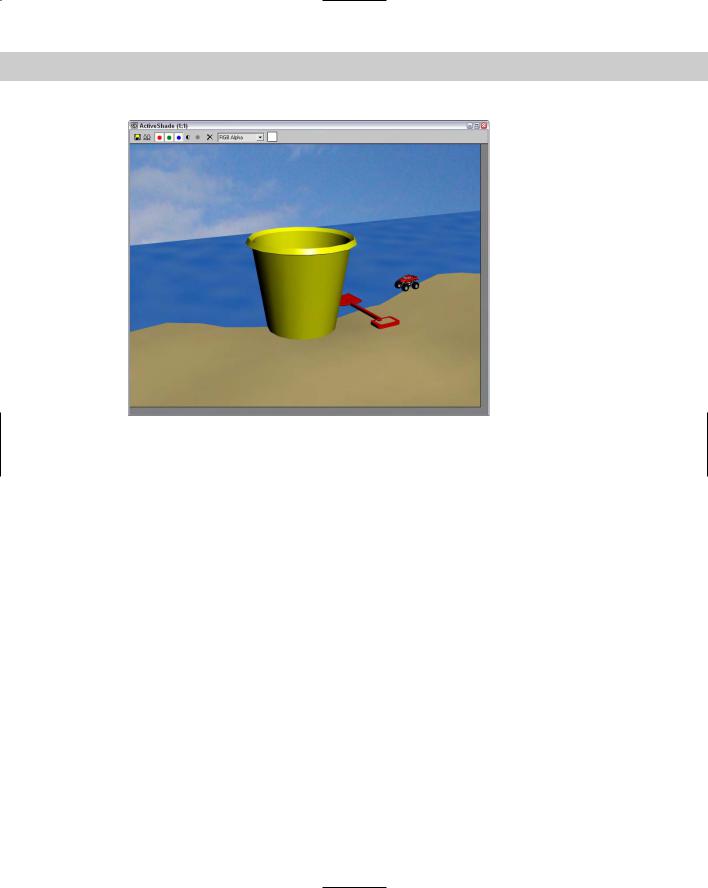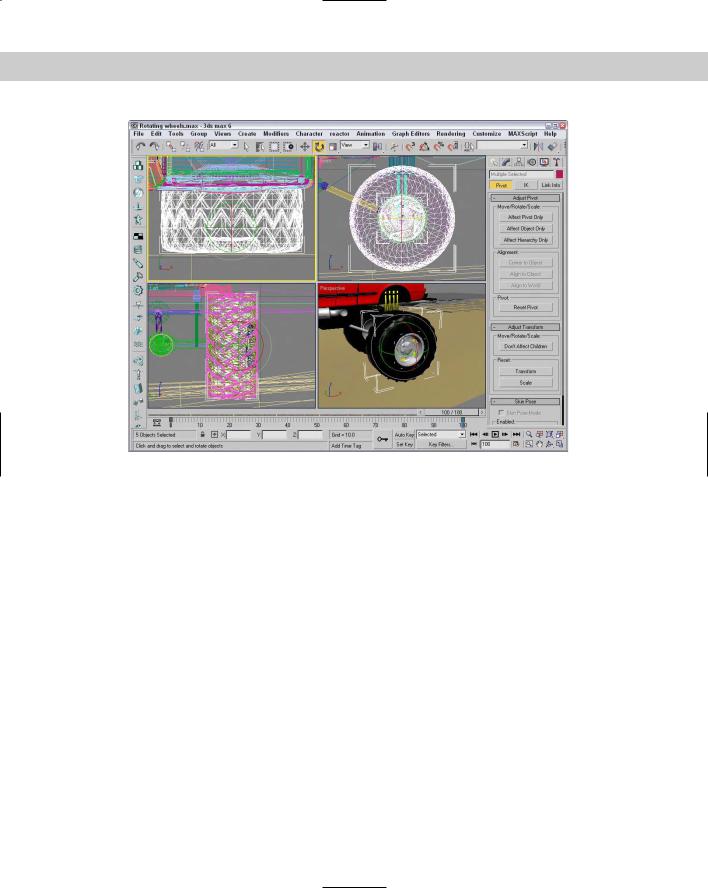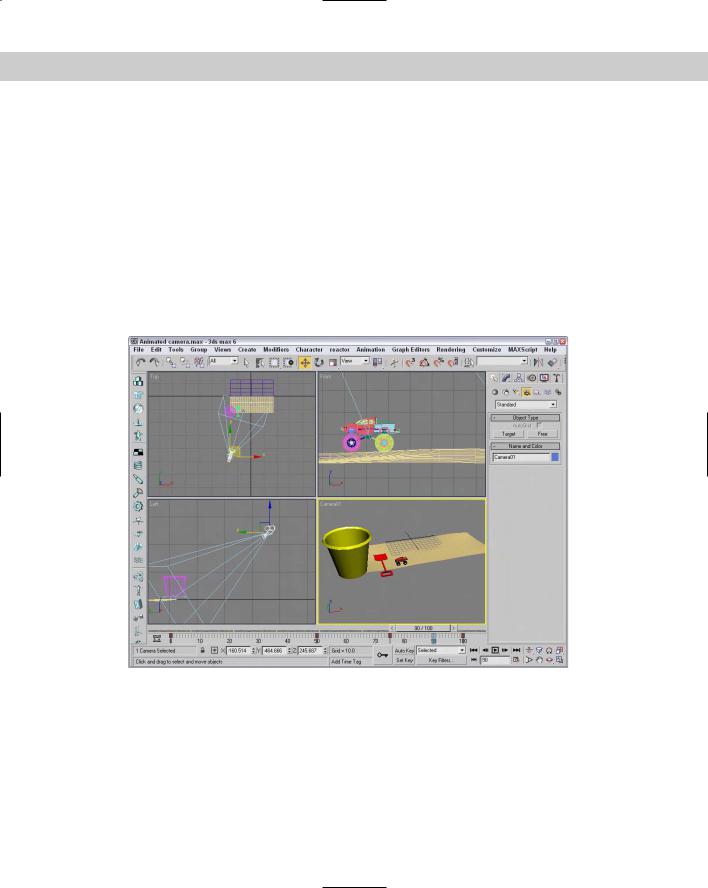
- •Preface
- •About This Book
- •Acknowledgments
- •Contents at a Glance
- •Contents
- •Relaxing at the Beach
- •Dressing the Scene
- •Animating Motion
- •Rendering the Final Animation
- •Summary
- •The Interface Elements
- •Using the Menus
- •Using the Toolbars
- •Using the Viewports
- •Using the Command Panel
- •Using the Lower Interface Bar Controls
- •Interacting with the Interface
- •Getting Help
- •Summary
- •Understanding 3D Space
- •Using the Viewport Navigation Controls
- •Configuring the Viewports
- •Working with Viewport Backgrounds
- •Summary
- •Working with Max Scene Files
- •Setting File Preferences
- •Importing and Exporting
- •Referencing External Objects
- •Using the File Utilities
- •Accessing File Information
- •Summary
- •Customizing Modify and Utility Panel Buttons
- •Working with Custom Interfaces
- •Configuring Paths
- •Selecting System Units
- •Setting Preferences
- •Summary
- •Creating Primitive Objects
- •Exploring the Primitive Object Types
- •Summary
- •Selecting Objects
- •Setting Object Properties
- •Hiding and Freezing Objects
- •Using Layers
- •Summary
- •Cloning Objects
- •Understanding Cloning Options
- •Mirroring Objects
- •Cloning over Time
- •Spacing Cloned Objects
- •Creating Arrays of Objects
- •Summary
- •Working with Groups
- •Building Assemblies
- •Building Links between Objects
- •Displaying Links and Hierarchies
- •Working with Linked Objects
- •Summary
- •Using the Schematic View Window
- •Working with Hierarchies
- •Setting Schematic View Preferences
- •Using List Views
- •Summary
- •Working with the Transformation Tools
- •Using Pivot Points
- •Using the Align Commands
- •Using Grids
- •Using Snap Options
- •Summary
- •Exploring the Modifier Stack
- •Exploring Modifier Types
- •Summary
- •Exploring the Modeling Types
- •Working with Subobjects
- •Modeling Helpers
- •Summary
- •Drawing in 2D
- •Editing Splines
- •Using Spline Modifiers
- •Summary
- •Creating Editable Mesh and Poly Objects
- •Editing Mesh Objects
- •Editing Poly Objects
- •Using Mesh Editing Modifiers
- •Summary
- •Introducing Patch Grids
- •Editing Patches
- •Using Modifiers on Patch Objects
- •Summary
- •Creating NURBS Curves and Surfaces
- •Editing NURBS
- •Working with NURBS
- •Summary
- •Morphing Objects
- •Creating Conform Objects
- •Creating a ShapeMerge Object
- •Creating a Terrain Object
- •Using the Mesher Object
- •Working with BlobMesh Objects
- •Creating a Scatter Object
- •Creating Connect Objects
- •Modeling with Boolean Objects
- •Creating a Loft Object
- •Summary
- •Understanding the Various Particle Systems
- •Creating a Particle System
- •Using the Spray and Snow Particle Systems
- •Using the Super Spray Particle System
- •Using the Blizzard Particle System
- •Using the PArray Particle System
- •Using the PCloud Particle System
- •Using Particle System Maps
- •Controlling Particles with Particle Flow
- •Summary
- •Understanding Material Properties
- •Working with the Material Editor
- •Using the Material/Map Browser
- •Using the Material/Map Navigator
- •Summary
- •Using the Standard Material
- •Using Shading Types
- •Accessing Other Parameters
- •Using External Tools
- •Summary
- •Using Compound Materials
- •Using Raytrace Materials
- •Using the Matte/Shadow Material
- •Using the DirectX 9 Shader
- •Applying Multiple Materials
- •Material Modifiers
- •Summary
- •Understanding Maps
- •Understanding Material Map Types
- •Using the Maps Rollout
- •Using the Map Path Utility
- •Using Map Instances
- •Summary
- •Mapping Modifiers
- •Using the Unwrap UVW modifier
- •Summary
- •Working with Cameras
- •Setting Camera Parameters
- •Summary
- •Using the Camera Tracker Utility
- •Summary
- •Using Multi-Pass Cameras
- •Creating Multi-Pass Camera Effects
- •Summary
- •Understanding the Basics of Lighting
- •Getting to Know the Light Types
- •Creating and Positioning Light Objects
- •Viewing a Scene from a Light
- •Altering Light Parameters
- •Working with Photometric Lights
- •Using the Sunlight and Daylight Systems
- •Using Volume Lights
- •Summary
- •Selecting Advanced Lighting
- •Using Local Advanced Lighting Settings
- •Tutorial: Excluding objects from light tracing
- •Summary
- •Understanding Radiosity
- •Using Local and Global Advanced Lighting Settings
- •Working with Advanced Lighting Materials
- •Using Lighting Analysis
- •Summary
- •Using the Time Controls
- •Working with Keys
- •Using the Track Bar
- •Viewing and Editing Key Values
- •Using the Motion Panel
- •Using Ghosting
- •Animating Objects
- •Working with Previews
- •Wiring Parameters
- •Animation Modifiers
- •Summary
- •Understanding Controller Types
- •Assigning Controllers
- •Setting Default Controllers
- •Examining the Various Controllers
- •Summary
- •Working with Expressions in Spinners
- •Understanding the Expression Controller Interface
- •Understanding Expression Elements
- •Using Expression Controllers
- •Summary
- •Learning the Track View Interface
- •Working with Keys
- •Editing Time
- •Editing Curves
- •Filtering Tracks
- •Working with Controllers
- •Synchronizing to a Sound Track
- •Summary
- •Understanding Your Character
- •Building Bodies
- •Summary
- •Building a Bones System
- •Using the Bone Tools
- •Using the Skin Modifier
- •Summary
- •Creating Characters
- •Working with Characters
- •Using Character Animation Techniques
- •Summary
- •Forward versus Inverse Kinematics
- •Creating an Inverse Kinematics System
- •Using the Various Inverse Kinematics Methods
- •Summary
- •Creating and Binding Space Warps
- •Understanding Space Warp Types
- •Combining Particle Systems with Space Warps
- •Summary
- •Understanding Dynamics
- •Using Dynamic Objects
- •Defining Dynamic Material Properties
- •Using Dynamic Space Warps
- •Using the Dynamics Utility
- •Using the Flex Modifier
- •Summary
- •Using reactor
- •Using reactor Collections
- •Creating reactor Objects
- •Calculating and Previewing a Simulation
- •Constraining Objects
- •reactor Troubleshooting
- •Summary
- •Understanding the Max Renderers
- •Previewing with ActiveShade
- •Render Parameters
- •Rendering Preferences
- •Creating VUE Files
- •Using the Rendered Frame Window
- •Using the RAM Player
- •Reviewing the Render Types
- •Using Command-Line Rendering
- •Creating Panoramic Images
- •Getting Printer Help
- •Creating an Environment
- •Summary
- •Creating Atmospheric Effects
- •Using the Fire Effect
- •Using the Fog Effect
- •Summary
- •Using Render Elements
- •Adding Render Effects
- •Creating Lens Effects
- •Using Other Render Effects
- •Summary
- •Using Raytrace Materials
- •Using a Raytrace Map
- •Enabling mental ray
- •Summary
- •Understanding Network Rendering
- •Network Requirements
- •Setting up a Network Rendering System
- •Starting the Network Rendering System
- •Configuring the Network Manager and Servers
- •Logging Errors
- •Using the Monitor
- •Setting up Batch Rendering
- •Summary
- •Compositing with Photoshop
- •Video Editing with Premiere
- •Video Compositing with After Effects
- •Introducing Combustion
- •Using Other Compositing Solutions
- •Summary
- •Completing Post-Production with the Video Post Interface
- •Working with Sequences
- •Adding and Editing Events
- •Working with Ranges
- •Working with Lens Effects Filters
- •Summary
- •What Is MAXScript?
- •MAXScript Tools
- •Setting MAXScript Preferences
- •Types of Scripts
- •Writing Your Own MAXScripts
- •Learning the Visual MAXScript Editor Interface
- •Laying Out a Rollout
- •Summary
- •Working with Plug-Ins
- •Locating Plug-Ins
- •Summary
- •Low-Res Modeling
- •Using Channels
- •Using Vertex Colors
- •Rendering to a Texture
- •Summary
- •Max and Architecture
- •Using AEC Objects
- •Using Architectural materials
- •Summary
- •Tutorial: Creating Icy Geometry with BlobMesh
- •Tutorial: Using Caustic Photons to Create a Disco Ball
- •Summary
- •mental ray Rendering System
- •Particle Flow
- •reactor 2.0
- •Schematic View
- •BlobMesh
- •Spline and Patch Features
- •Import and Export
- •Shell Modifier
- •Vertex Paint and Channel Info
- •Architectural Primitives and Materials
- •Minor Improvements
- •Choosing an Operating System
- •Hardware Requirements
- •Installing 3ds max 6
- •Authorizing the Software
- •Setting the Display Driver
- •Updating Max
- •Moving Max to Another Computer
- •Using Keyboard Shortcuts
- •Using the Hotkey Map
- •Main Interface Shortcuts
- •Dialog Box Shortcuts
- •Miscellaneous Shortcuts
- •System Requirements
- •Using the CDs with Windows
- •What’s on the CDs
- •Troubleshooting
- •Index

Chapter QS Quick Start: Animating a Monster Truck at the Beach |
13 |
Figure QS-8: The background image adds to the beach scene.
Animating Motion
After loading and positioning all the models and dressing them with materials, you can add motion to the scene by animating the objects. Animations can consist of moving objects, like the truck, as well as secondary motion, like rotating the tires as the truck moves. Animation is not limited to models; in this section we animate the camera too.
Special effects can also be part of the animating process. In this project we use a particle system, which consists of many small particles that combine to look like a cloud of dust.
Tutorial: Animating the monster truck motion
By now, I’m sure that the monster truck is feeling very ready to throw some dirt around. To animate the truck, we want to move it forward and rotate the wheels. The animation method we’re using is keyframes. This works by setting a beginning position and an ending position and letting Max compute all the in-between positions.
To animate the monster truck moving, follow these steps:
1.First, we move the truck to its starting position at the end of the sand away from the toy shovel and pail, but first we need to pan and zoom the Top viewport. Click and drag the Top viewport with the middle scroll wheel button to pan the viewport to the left. Then roll the middle scroll wheel to zoom out of the Top viewport so you can see the truck and most of the sand behind it. Then click the Select and Move tool (W), and drag the truck to the lower-right corner of the “Sand” plane object.

14 |
Part I Learning the Max Interface |
2.With the truck selected, press the Z key to zoom in on it in all viewports. Then with the Select and Move tool (W), drag the truck up in the Front viewport until its wheels are above the “Sand” plane.
3.Right-click the Top viewport to make it the active viewport, and with the middle scroll wheel, zoom out of the view so you can see the shovel object again.
4.Before we animate the monster truck, we need to ungroup it so we can animate the wheels independent of the group. Select Group Ungroup to ungroup the truck.
5.Click the Auto Key button (or press the N key), and drag the Time Slide to frame 100. Auto Key mode records all transforms as keys. Click the Select and Move (W) tool, and drag the truck from its position to the left in the Top viewport until it is just right of the shovel.
6.Click the Auto Key button again to turn off Auto Key mode, and click the Play button (/) to see the truck move in the Top viewport. Click the Pause button to stop the animation, and drag the Time Slider back to frame 0.
This tutorial is saved as Moving truck.max. Animating the movement of the truck is only half the battle. We still need to animate the wheels rotating.
Tutorial: Animating the rotating wheels
The next animation task is to animate the rotating wheels. Because there are four wheels, you can select the wheel and rim objects, position their pivot point to the center of the selected objects, and create the animation.
To animate the wheels rotating, follow these steps:
1.With the truck selected, press the Z key to zoom in on the truck in all viewports.
2.Select the wheel and the rim of one of the tires by dragging over the wheel in the Top viewport. This also selects the “Sand” plane underneath, so hold down the Ctrl key and click the “Sand” plane to deselect it.
3.Before you can rotate the wheel, you need to set the location about which it rotates, which should be the center of the wheel. Open the Hierarchy panel in the command panel, and with the Pivot button selected, click the Affect Pivot Only button. The Pivot is the point about which the rotations take place. Then click the Center to Object button. This places the Pivot at the center of the wheel. Then click the Affect Pivot Only button again to exit Pivot mode.
4.With the entire wheel and rim selected, click the Select and Rotate (E) tool on the main toolbar. Then press the Auto Key button (or press the N key), and drag the Time Slider over to frame 100. Then press the Z key to zoom in on the wheel in all viewports. Select Tools Transform Type-In (or press the F12 key), and enter a value of –7200 in the Offset:Screen field for the Y axis. Close the Transform Type-In floater, and disable Auto Key mode.
5.With the middle mouse button held down, drag in the Top viewport until another one of the tires is visible. Repeat Steps 2 through 4 for this wheel and then drag the viewport again and repeat until all four tires are animated.
Figure QS-9 shows a tire selected and animated. This tutorial is saved as Rotating wheels.max.

Chapter QS Quick Start: Animating a Monster Truck at the Beach |
15 |
Figure QS-9: Subtle animation pieces like rotating tires are essential for a realistic scene.
Tutorial: Positioning and animating a camera
With the monster truck animated, you’re now ready to add a camera to the scene and animate its motion. Initially, we want it to focus on the monster truck and then slowly dolly away from its focus to reveal the entire scene.
To add a camera to the scene and animate its motion, follow these steps:
1.Zoom out and pan with the middle scroll wheel in the Top viewport until you can see most of the “Sand” pane, and then drag the Time Slider back to frame 0. Then select Create Cameras Target Camera, and click and drag in the Top viewport near the truck to create a camera.
2.In the Left viewport, zoom out, right-click the Target Camera, and choose the Select Camera Target option from the pop-up quadmenu. Click the Select and Move (W) tool, and drag the camera target up toward the center hub between the tires beneath the monster truck. Then click the Select and Link button on the main toolbar, and drag from the Camera Target to the center hub object to link the two together.
This causes the camera to point at this object wherever the truck moves.
3.Select the Perspective viewport, and right-click the Perspective title in the viewport in the upper-left corner. In the pop-up menu that appears, select Views Camera01.
This changes the Perspective viewport to a view from the camera object.

16 |
Part I Learning the Max Interface |
4.Drag the camera object in the Top and Left viewports until the Camera01 viewport shows a good close-up of the monster truck. Then click the Auto Key button (N) to enable this mode, and drag the Time Slider to frame 50. Using the Select and Move button (W), position the camera in the Top and Left viewports to show another close-up of the monster truck.
5.With the Auto Key button still enabled, drag the Time Slider to frame 75 and move the camera up and away from the truck in the Top and Left viewports. Then drag the Time Slider to frame 100, and drag the camera even further so the toy shovel and pail are visible. Click the Auto Key button again to disable it.
6.Right-click the Camera01 viewport to make it the active viewport, and click the Play Animation button (/) to see the resulting animation.
This tutorial is saved as Animated camera.max. Figure QS-10 shows the final position of the camera.
Figure QS-10: Linking the camera target to an object ensures that the object is always visible.

Chapter QS Quick Start: Animating a Monster Truck at the Beach |
17 |
Tutorial: Adding special effects
Special effects are the little extras that you add to an animation that make the scene a little more believable, and one of the best ways to add effects in Max is using particle systems. For this animation, we use a particle system to kick up some dust from the tires as the truck moves along.
To add some dust to the truck motion using particle systems, follow these steps:
1.Drag the Time Slider back to frame 0, select a rear wheel, and press the Z key to zoom in on it.
2.Select Create Particles Super Spray, and drag in the Top viewport to create a Super Spray icon. Click the Select and Rotate (E) tool, and rotate the icon in the Top and Front viewports until the icon’s arrow points up and outward from the bottom of the wheel.
3.With the Super Spray icon selected, open the Modify panel and, in the Basic Parameters rollout, set the Off Axis Spread value to 30 and the Off Plane Spread value to 45. In the Particle Generation rollout, select the Use Rate option with 1000 particles, and set the Speed to 2.0 with a Variation to 80% and the Emit Stop value to 95. Set the Life value to 20 with a Variation of 75, and a Size value of 0.5 with a Variation of 20%. In the Particle Type rollout, select the Facing option.
4.Press the M key to open the Material Editor, drag the “Sand” material to an open sample slot, and name the material Sand particles. Set the Opacity value to 15, and click the mapping shortcut for the Diffuse color. In the Material/Map Browser, double-click the Smoke map and set its colors to light brown and white. Then drag the “Sand particles” material to the Super Spray icon.
5.In the Top viewport, hold down the Shift key and drag the Super Spray icon upward to clone another particle system for the other rear wheel. In the Clone Options dialog box that opens, click OK.
6.Click the Select and Link tool on the main toolbar, and drag from each Super Spray icon to the rear bumper object in the Front viewport.
This links the particle systems so they travel with the truck.
Having a monster truck kick up a little dust adds to the render time, but the effect is worth it and makes the monster truck in the earlier scenes look like a real machine. Figure QS-11 shows a rendered frame of the particles being emitted behind the truck. This tutorial is saved as Dust particles.max.
